Choosing the right tile combinations can turn an ordinary bathroom into something you actually look forward to using. Since you start and end your day here, why not make it both functional and beautiful? As 2025 approaches, some tile pairings just keep working, and new trends keep popping up too.
Remember to repin your favorite images!
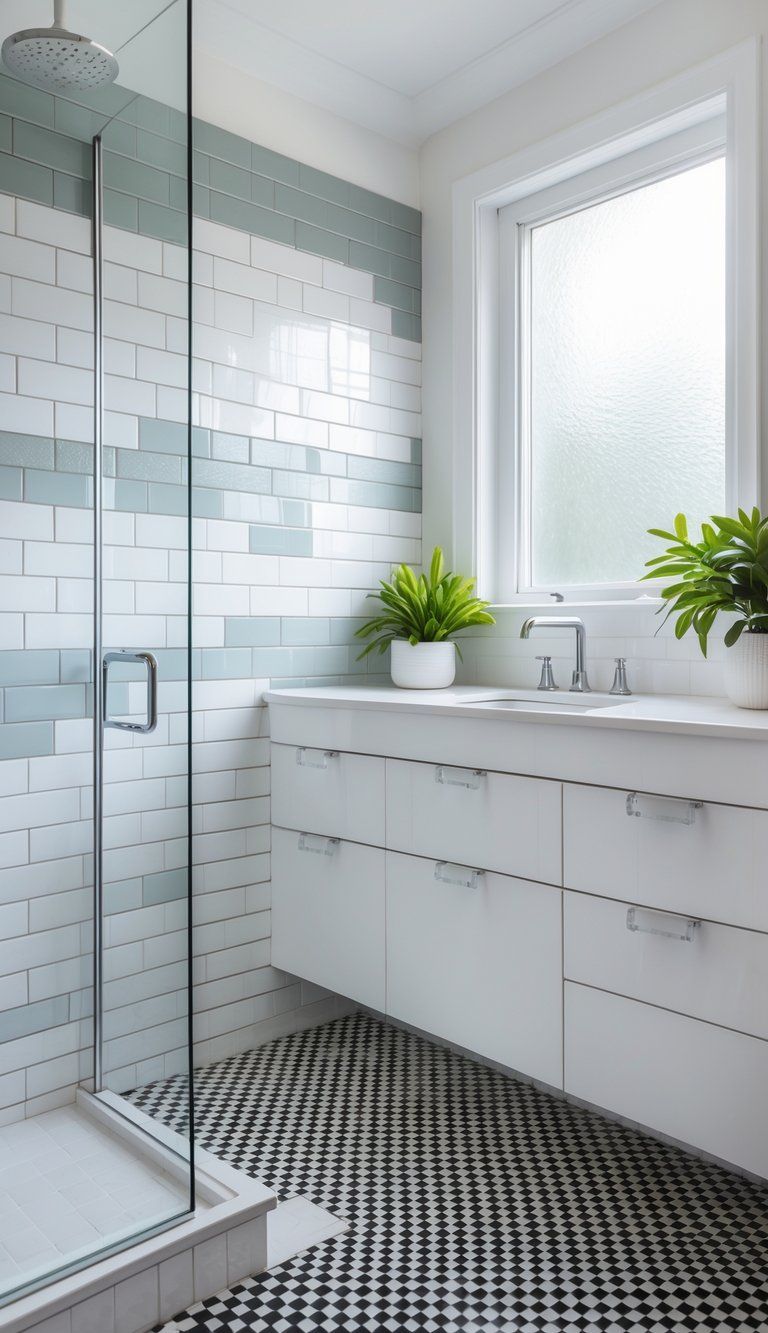
The best bathroom tile combinations always seem to balance contrast, texture, and color, creating a look that feels personal and timeless. For example, glossy white tiles with navy blue mosaics give off a fresh coastal vibe. If you combine stone tiles with classic subway patterns, your space instantly gains depth and character.
Try pairing wood-look porcelain with concrete-style tiles for a cozy-meets-industrial feel. That mix really brings warmth and a bit of edge.
Your bathroom deserves more than just plain tiles. The right pairing can warm up a cold space, make a small bath feel bigger, or even turn a basic shower into a spa escape.
If you love natural stone textures, bold patterns, or classic white with just a hint of color, there’s definitely a combo out there for you.
Fundamentals of Successful Bathroom Tile Combinations
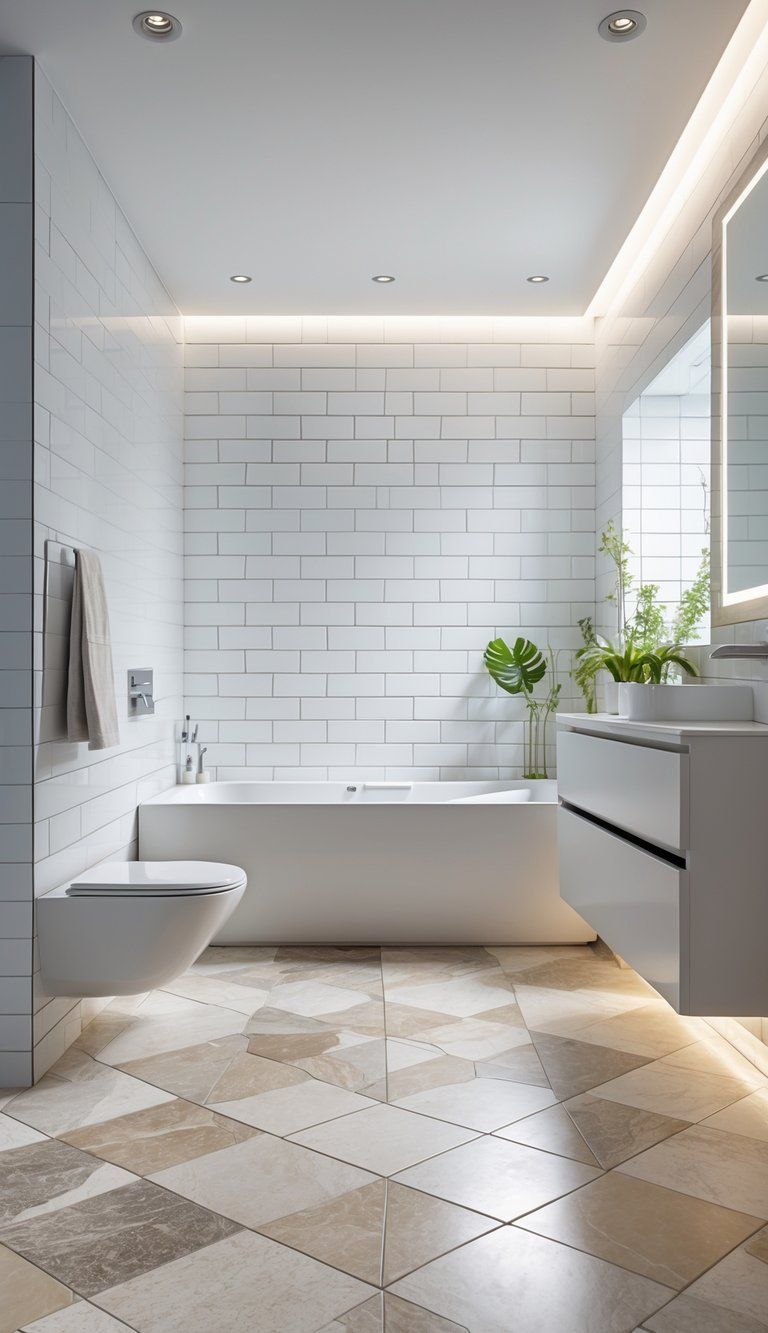
Designers usually start with a few simple principles when creating great bathroom spaces. If you keep these in mind, picking out and mixing tiles gets a lot less stressful.
Understanding Color Harmony
Color probably matters more than anything else in bathroom tile design. Begin with a basic color scheme—here are a few tried-and-true approaches:
- Monochromatic: Use different shades of the same color for depth without chaos.
- Complementary: Opposites on the color wheel (like blue and orange) add energy.
- Analogous: Next-door colors on the wheel give a peaceful, harmonious vibe.
Whites, grays, and beiges make great base colors. They’re flexible and never really go out of style. Sprinkle in accent colors with smaller tiles or details.
If your bathroom is on the small side, lighter colors can help it feel more open. Darker shades can be striking, but they work best as accents or in bigger spaces where you won’t feel boxed in.
Balancing Tile Sizes
The size of your tiles changes the whole feel of the room.
Large tiles (think 12″×24″ or even bigger) make small bathrooms look more open by cutting down on grout lines. They’re awesome on floors and shower walls for a modern, seamless look.
Tiny tiles like mosaics (2″×2″ or less) add texture and detail. They’re great for accent walls, shower floors, or as borders.
A solid formula is:
- Large floor tiles for an open feel.
- Medium wall tiles for everyday surfaces.
- Small decorative tiles as borders or accents.
Mixing up sizes keeps things interesting but balanced. Just remember, different sizes might need different installation skills, so talk it over with your installer.
Mixing Finishes and Textures
Blending finishes brings your bathroom to life.
Glossy tiles bounce light around, making any space feel bigger and brighter. These work well in small bathrooms or dark corners. Just be careful—they can get slippery on floors.
Matte tiles hide water spots and offer better grip. They’re subtle and sophisticated, especially underfoot.
Try combos like:
- Smooth porcelain on the walls with textured stone-look tiles on the floor.
- Glossy subway tiles mixed with matte mosaic accents.
- Textured tiles in the shower, smooth everywhere else.
A little contrast goes a long way, but don’t go overboard on textures or things can start to look messy.
Classic Bathroom Tile Pairings That Never Fail
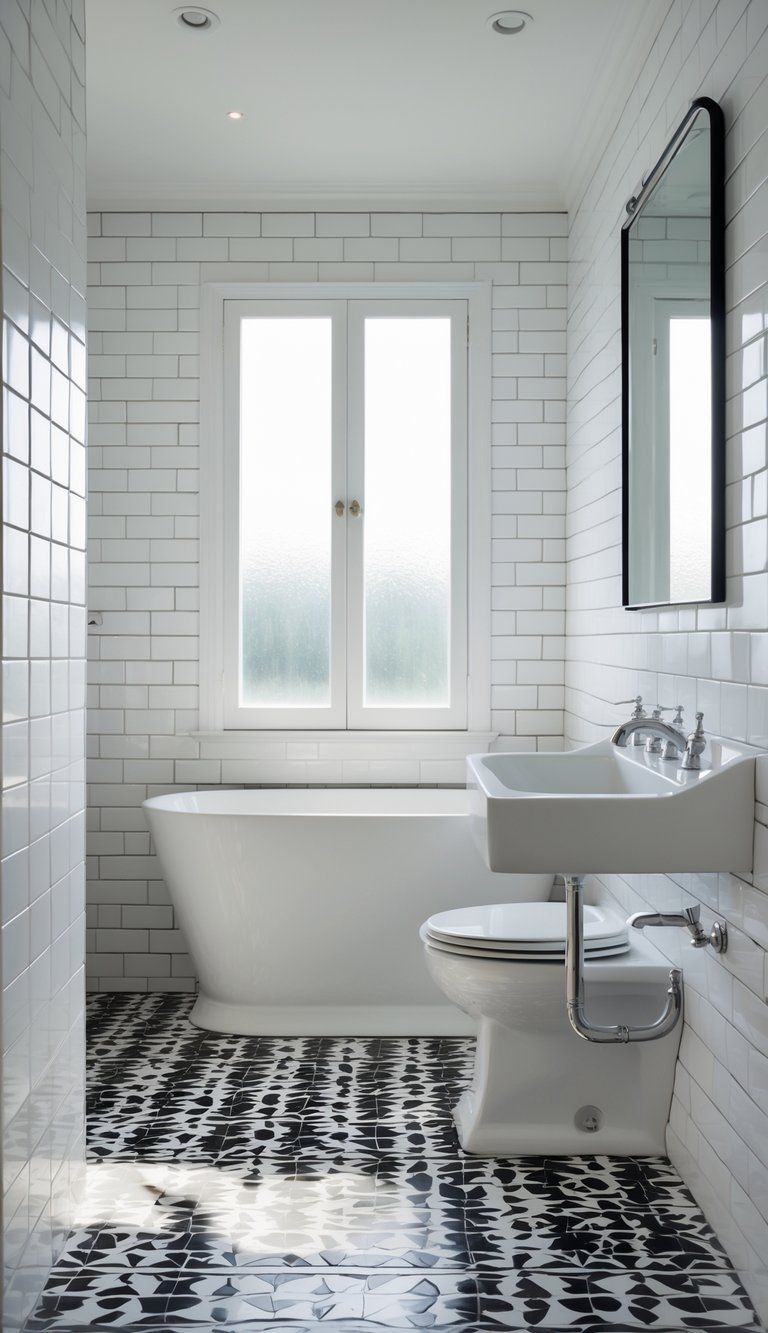
Some tile combos just never go out of style. You see them year after year, and there’s a reason—they always look good.
White Subway Tiles with Marble Accents
White subway tiles make a clean, timeless backdrop. These 3×6 inch rectangles, with their slight bevels, create subtle shadows and texture.
Try pairing white subway tiles with marble accents. Use marble for shower niches, countertops, floors, or as a border.
Marble’s natural veining adds a luxurious touch to all that crisp white. Carrara or Calacatta marble, with their gray or gold veins, work especially well for that timeless vibe.
This combo fits any bathroom size. In small spaces, stick to subway on the walls and sprinkle in marble accents. If you’ve got more room, try a marble floor with subway-tiled walls.
Black and White Checkerboard Patterns
Black and white checkerboard floors have been around forever. They make a big impact without feeling trendy.
The classic look uses 12×12 inch tiles in a simple alternating pattern. For something different, try smaller 4×4 tiles, hexagons, or even marble with subtle veining.
Pair checkerboard floors with white walls for a look that’s bold but not overwhelming. Brass or chrome fixtures really bring out the vintage charm.
This pattern is perfect for old-school or retro bathrooms. The contrast anchors the whole room and gives you a solid base to work from.
Mosaic Floors with Neutral Wall Tiles
Mosaic floors, with their tiny, detailed patterns, bring instant character to a bathroom.
Classic mosaics include penny rounds, basket weave, hexagons, or even Greek key borders.
Keep the walls simple with light gray, soft beige, or white tiles. That way, the floor becomes the star, and the rest of the space stays calm.
This mix works because it balances busy with simple. The mosaic gives you personality, while the neutral walls keep things grounded.
If you want everything to tie together, pull a color from your mosaic for your towels or other accents.
Modern Bathroom Tile Combinations for a Fresh Look
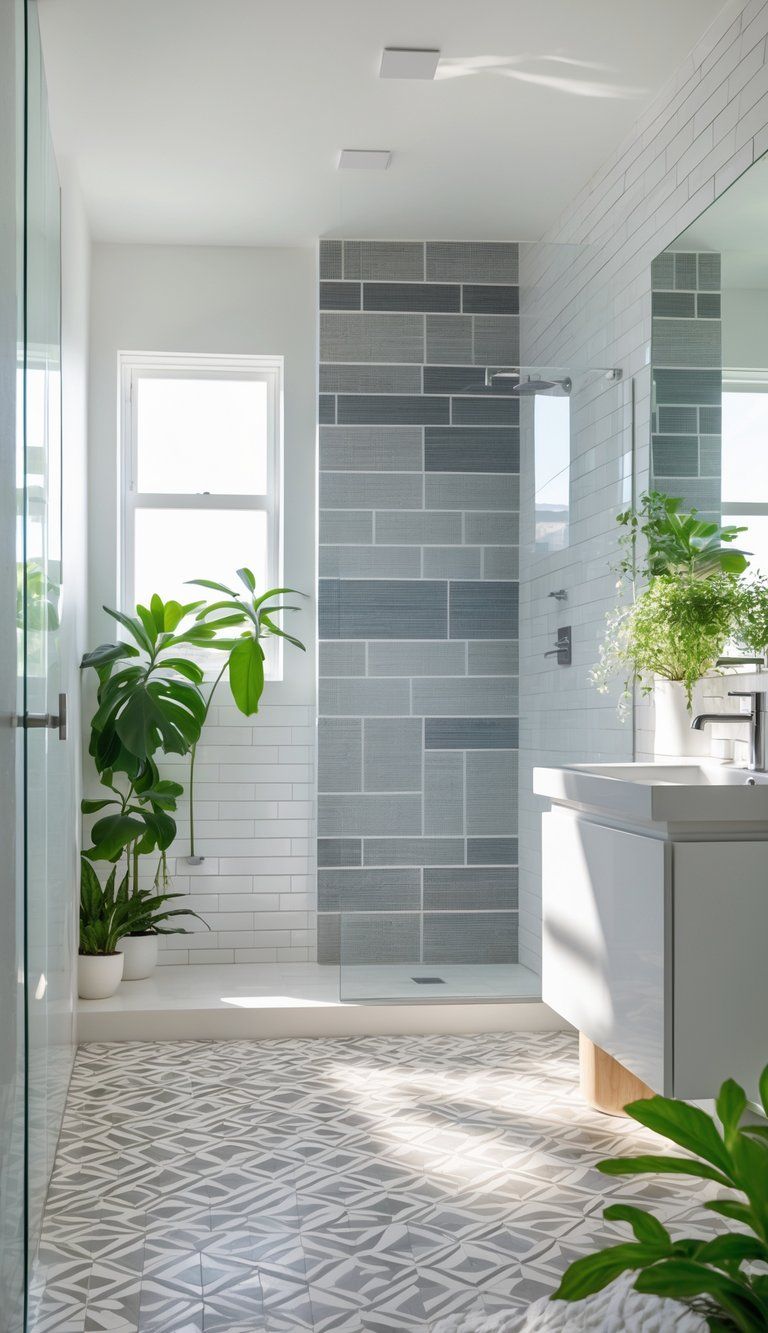
Modern bathrooms really pop with the right tile mix. Two approaches seem to stand out: geometric patterns that add punch, and textured whites that keep things fresh and clean.
Geometric Wall Tiles with Contrasting Floor Tiles
Geometric patterns are a go-to for modern bathrooms. Patterned walls paired with solid floors keep the space from feeling too busy.
Try hexagon tiles on the shower walls with big rectangular floor tiles in a matching or contrasting color. This works great in small bathrooms—visual interest can make the space feel bigger.
Black and white geometric combos are always a win. White hexagons with black grout on the wall and matte black floors create a dramatic look.
For something quieter, go for tone-on-tone. Light gray geometric walls with darker gray floors feel sophisticated but not overwhelming.
Textured White Tiles with Bold Accent Colors
Textured white tiles add interest without losing that clean, airy feeling. The texture plays with the light throughout the day.
Some options:
- Fluted or ribbed tiles for vertical lines
- Raised geometric patterns
- Subtle waves that look like water
Pair textured whites with bold colors for a real statement. Textured white walls and deep blue floors, or a colorful vanity, look fantastic.
Adding plants softens the modern vibe and brings in some nature. Even just a couple of green touches can make the whole bathroom feel more like a retreat.
Color-Driven Bathroom Tile Ideas
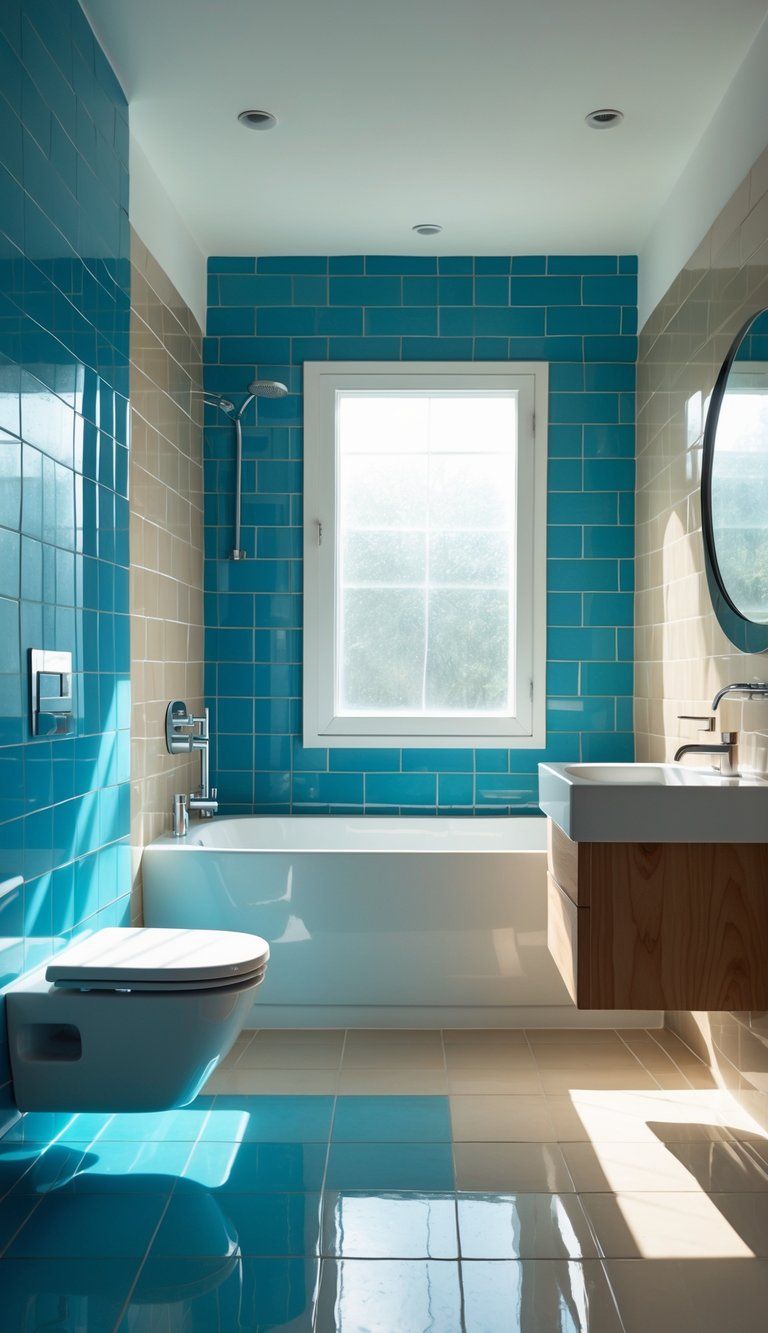
Color can take your bathroom from basic to wow. Think about your own style and how different colors interact to create a mood.
Blue Tiles with Metallic Accents
Blue tiles always seem to bring a sense of calm, almost like a spa. Lighter blue shades feel peaceful and pair well with silver or brushed nickel fixtures. If you want drama, go for navy or cobalt.
Some combos to try:
- Pale blue subway tiles with brass hardware
- Navy penny tiles with gold accents
- Teal hexagons with chrome fixtures
Metallic touches add shine and a bit of luxury. You can bring these in with metal trim, metallic grout, or your fixtures.
If your space is small, stick with lighter blues to open it up. Use blue tiles in the shower or as an accent wall for a pop that doesn’t overwhelm.
Earthy Tones with Terracotta and Pink Tile
Earthy palettes feel cozy and natural. Terracotta, with its warm orange-brown, creates a grounded, timeless base.
It pairs well with:
- Soft pink tiles
- Creamy whites and beiges
- Natural wood accents
Pink tiles, especially in blush or dusty rose, add a soft, unexpected element. They look best in bathrooms with lots of natural light.
Quick tip: Go for simple fixtures in matte black or brushed brass so your tiles stay the focus.
Try things like:
- Terracotta floors with pink subway accents
- Pink hexagons bordered by terracotta
- A terracotta feature wall with pink mosaic details
Emerald Green Tiles with Marble Mosaic
Emerald green tiles bring a rich, jewel-toned look that’s dramatic but still classic.
You can pair green tiles with marble mosaics in several ways:
- Emerald subway tiles with marble penny tile floors
- Green squares next to marble basketweave patterns
- Marble herringbone walls with green tile surrounds
Marble types that work best:
- Carrara (gray veins)
- Calacatta (gold veins)
- Statuario (bold, dramatic veins)
Keep the marble mosaic to one area, like the shower floor or behind the vanity, and use emerald green tiles elsewhere.
This combo works in bathrooms big or small. In a smaller space, use more marble and less green for an airy feel. In a larger room, go bold with emerald for a real statement.
Perfecting Shower Niches With Tile Combinations
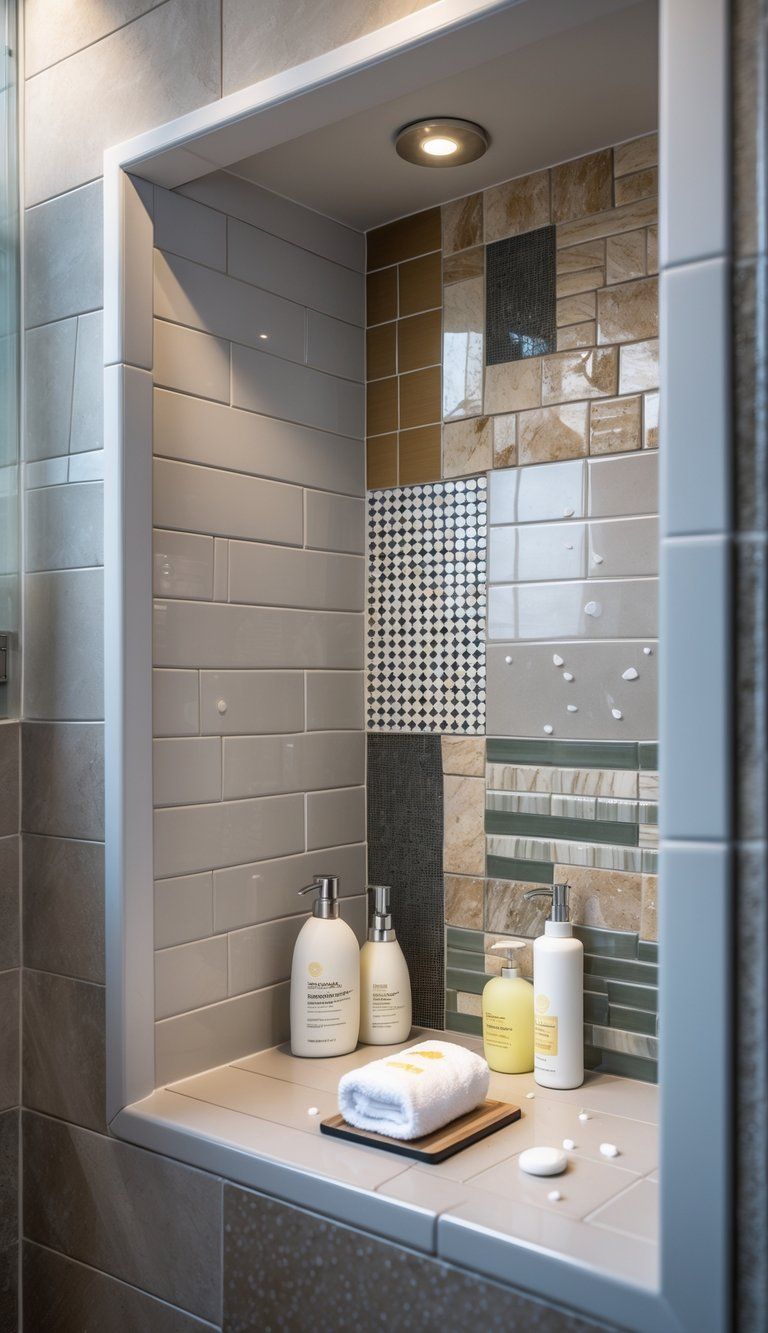
Shower niches do more than just store shampoo—they add style and function. The right tile combo can turn this practical spot into a highlight that upgrades your whole shower.
Mosaic Tiles in Shower Niches
Mosaic tiles really liven up shower niches and make them pop against the rest of the wall. You can play with small square, hex, or penny tiles to add texture and depth.
These little tiles fit nicely in niches since you don’t have to cut them much. That alone makes life easier.
Try mixing things up with mosaics:
- Contrasting colors: Go for dark mosaics in a pale shower or the other way around.
- Complementary materials: Pair glass mosaics with ceramic tiles for a cool effect.
- Pattern play: Arrange different colored mosaics in geometric patterns if you’re feeling adventurous.
If you want everything to flow together, pick mosaic tiles that pull in colors from your main shower tiles. That way, you get a subtle link without things looking too matchy.
Dimensional Tiles for Depth
Dimensional tiles add instant texture and depth to shower niches, making them stand out from flat shower walls. These tiles have raised patterns, wavy effects, or surfaces that catch the light in all sorts of ways.
Some popular choices:
- Beveled subway tiles with angled edges
- Textured ceramic tiles with ripples
- 3D geometric patterns that throw interesting shadows
Keep your main shower walls simple and let the dimensional tiles shine inside the niche. It creates this little jewel-box vibe that really grabs your attention.
Lighting can make or break dimensional tiles. Try adding a small waterproof light above your niche to show off the texture and get those dramatic shadows.
Small and Large Bathroom Tile Combinations
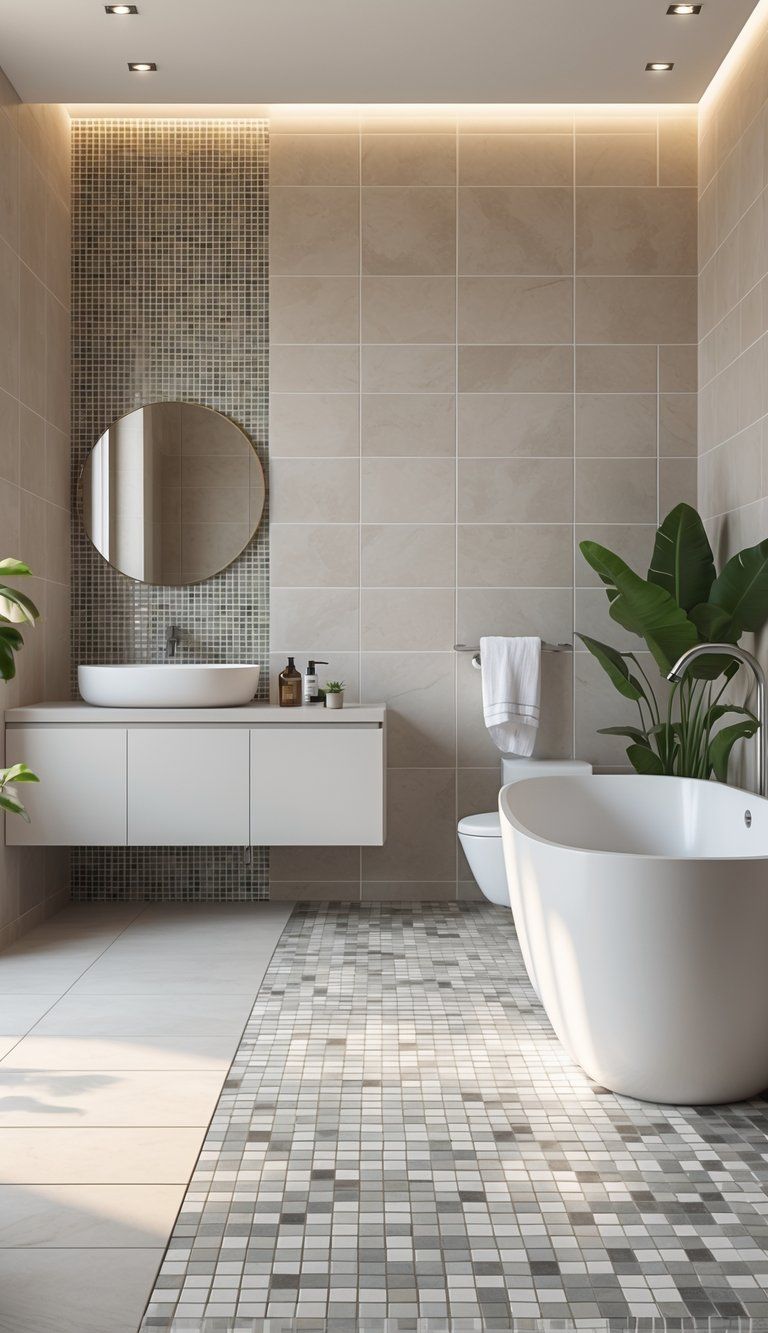
Mixing up tile sizes can totally change how your bathroom feels. The contrast between big and small tiles draws the eye and helps solve tricky design problems.
Using Large Tiles to Create Spaciousness
Large-format tiles make small bathrooms look way bigger. When you put these big tiles (think 12″x24″ or more) on floors or walls, you get fewer grout lines and a seamless look.
Your eye just glides across the space, which is honestly kind of magical.
Stick to light colors like white or soft gray for large tiles—they bounce more light around and really open things up. For the best effect, use the same big tile on both the floor and shower walls.
That consistency helps the bathroom feel unified instead of chopped into pieces.
Try installing large tiles horizontally on walls if your bathroom is narrow. It tricks the eye into seeing a wider space.
In small powder rooms, choose large tiles with simple patterns so things don’t get too busy.
Mixing Small Mosaics with Standard Tiles
Small mosaics (2″x2″ or less) add texture and interest when you pair them with standard tiles. Use them in shower niches, as accent strips, or on a feature wall to create a focal point.
If you want balance, go with neutral standard tiles and bring in color or pattern through the mosaics. It lets you show off some personality without losing cohesion.
Mosaic tiles are awesome for wet spots like shower floors because all those grout lines help prevent slips. Penny rounds or hex mosaics on the floor combined with classic subway tiles (3″x6″) on the walls? That’s a combo that just works.
In a small bathroom, stick to mosaics in only one area so things don’t feel cluttered.
Accessorizing and Enhancing Bathroom Tile Designs
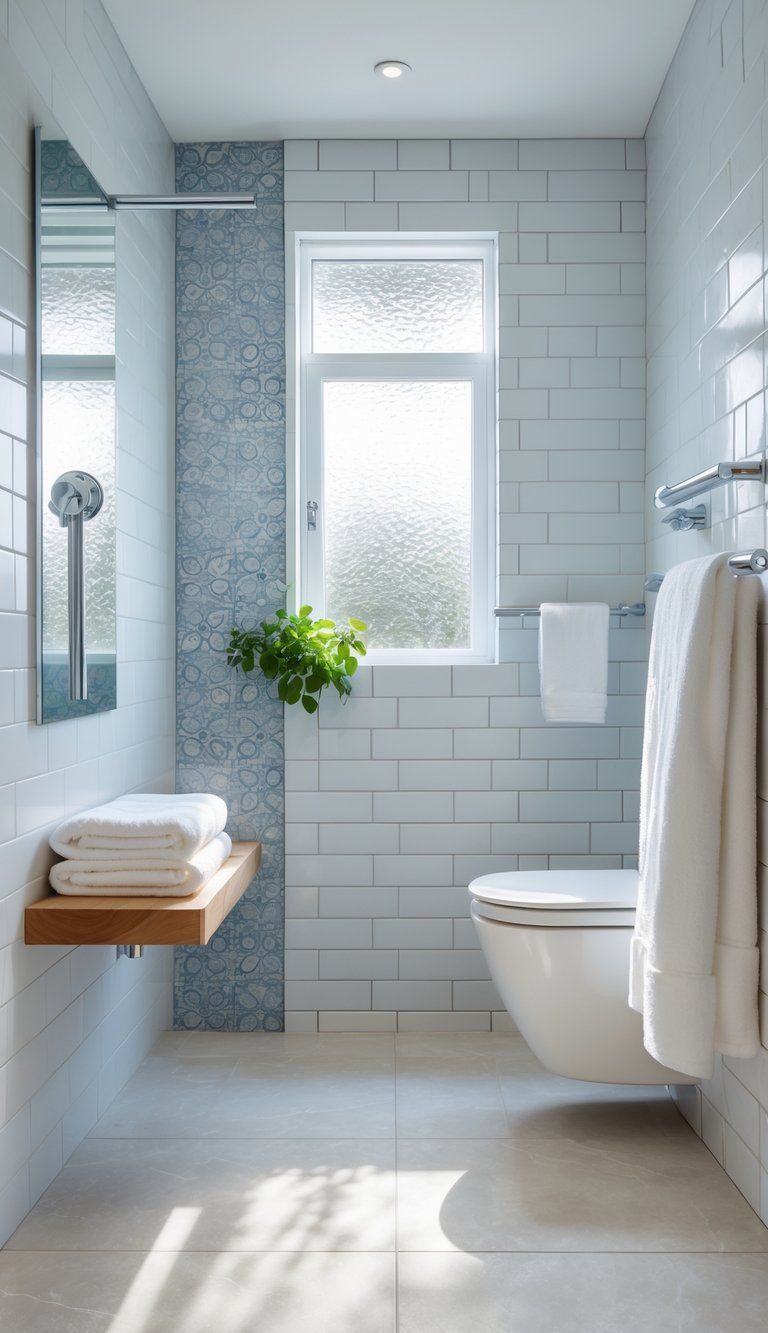
The right accessories and finishing touches can take your bathroom tile from just okay to seriously impressive. It’s the details that make your design feel personal and pulled together.
Choosing the Right Grout Colors
Grout isn’t just about function anymore—it’s a style choice. White grout with white tile gives a crisp, seamless look.
On the other hand, dark grout with light tile really highlights the pattern and hides stains.
For a softer effect, pick grout that’s a shade or two lighter or darker than your tile. If you want something bold, try black grout with white subway tiles for serious contrast.
Colored grouts are coming in strong for 2025. Soft blue or green grout with neutral tiles? It’s a subtle pop of color that feels fresh.
Just remember, grout in wet or high-traffic spots needs to be sealed well so it doesn’t stain or mildew.
Pro tip: Epoxy grout on shower walls and floors lasts longer and shrugs off stains.
Incorporating Accessories and Details
Your accessories should work with your tile, not fight it. If you’ve got busy patterned floors, keep wall décor simple and minimal.
If your tile is more understated, you can add a few more decorative pieces.
Match your metal finishes on faucets, towel bars, and shower frames for a cohesive look. Mixed metals are still in—brushed brass with matte black is a combo that just oozes style.
A few little details can really elevate the space:
- Glass shelves for fancy soaps and toiletries
- Humidity-loving plants
- Textured towels that echo your tile colors
- Wooden bath mats for a cozy touch
Lighting matters a lot. Sconces at eye level help banish shadows, and overhead lights show off textured tiles. If you have patterned floor tile, go for simple pendant lights so the floor stays the star.
Trends and Timeless Looks in Bathroom Tile Combinations
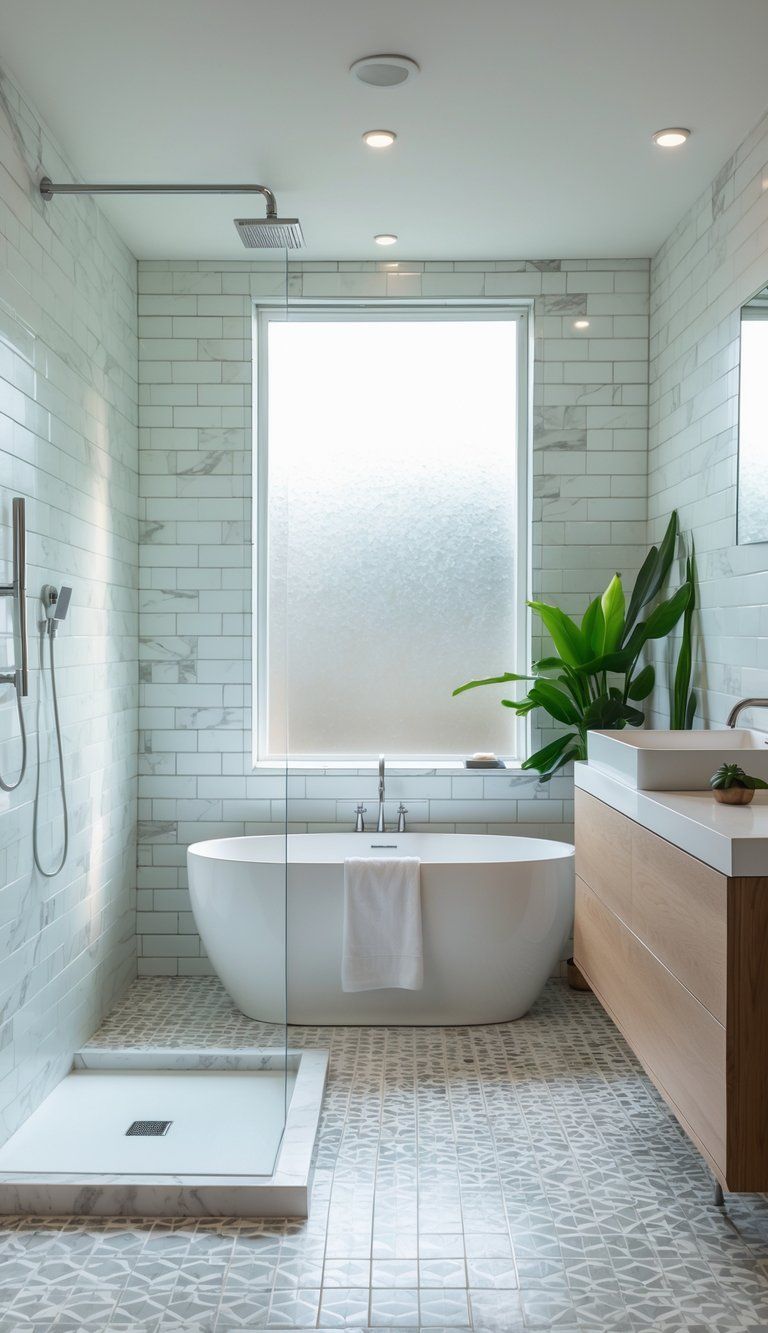
Bathroom tile trends shift every year, but some combos just never go out of style. The right mix can take your bathroom from forgettable to something special.
Hexagonal Tiles for Modern Appeal
Hex tiles add geometric flair to any bathroom. These six-sided shapes bring movement and work in both big and small spaces.
Here are a few ways to use them:
- All-white hexagons for a clean, classic vibe
- Black and white patterns if you’re into contrast
- Colored hex tiles as an accent wall behind the vanity
Small hex tiles look fantastic on floors for a vintage feel that somehow still feels current. Large hex tiles on the wall make a bold statement without overwhelming everything.
Try pairing hex floor tiles with simple rectangular wall tiles. It keeps things interesting without looking chaotic.
Rectangular Tiles in Creative Layouts
People keep choosing rectangular tiles—especially subway tiles—for bathrooms, and honestly, it makes sense. You can do so much with them, and the way you lay them out totally transforms the vibe.
Here are a few favorite ways to arrange rectangular tiles:
- Herringbone pattern gives you that extra visual texture.
- Vertical stacking makes the walls look taller, which is always nice.
- Traditional horizontal layout—classic, never goes out of style.
If you want something a bit different, navy subway tiles bring in rich color but still keep that timeless shape everyone loves. You can really use them in just about any bathroom, no matter the style.
For a more modern feel, try out large rectangular tiles and keep the grout lines thin. That way, you get this smooth, seamless look, and cleaning them is a breeze.
You can even mix glossy and matte versions of the same tile shape. It adds a little bit of dimension but doesn’t make the design too busy.

